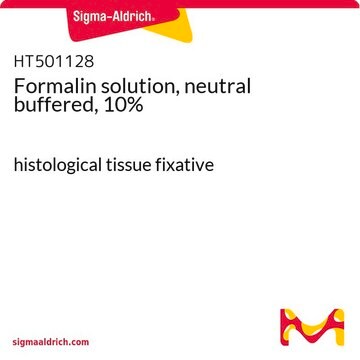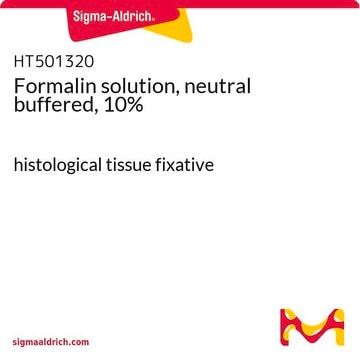The temperature used for standard tissue processing historically has been room temperature. Temperature can affect the rate of fixation, and modern tissue processors may use elevated temperatures to reduce processing time without adverse effects on tissue morphology. Cold fixation is common in electron microscopy when using glutaraldehyde as a fixative.
1.00496
Formaldehyde solution 4%, buffered, pH 6.9
(approx. 10% Formalin solution) for histology
Synonyme(s) :
Formaline solution, Methanal solution, Methyl aldehyde solution
About This Item
hematology
histology
Produits recommandés
Niveau de qualité
Forme
liquid
IVD
for in vitro diagnostic use
Concentration
3.8-4.2% (acidimetric)
Couleur
colorless
pH
6.7-7.1 ( in H2O)
pb
100 °C/1013 hPa
Pf
-92 °C
Densité
1.017 g/cm3 at 20 °C
Application(s)
diagnostic assay manufacturing
hematology
histology
Température de stockage
15-25°C
Description générale
Mention d'avertissement
Danger
Mentions de danger
Conseils de prudence
Classification des risques
Acute Tox. 4 Inhalation - Acute Tox. 4 Oral - Carc. 1B - Muta. 2 - Skin Sens. 1
Code de la classe de stockage
6.1D - Non-combustible, acute toxic Cat.3 / toxic hazardous materials or hazardous materials causing chronic effects
Classe de danger pour l'eau (WGK)
WGK 3
Point d'éclair (°F)
Not applicable
Point d'éclair (°C)
Not applicable
Listes réglementaires
Les listes réglementaires sont principalement fournies pour les produits chimiques. Seules des informations limitées peuvent être fournies ici pour les produits non chimiques. L'absence d'indication signifie qu'aucun des composants n'est répertorié. Il incombe à l'utilisateur de s'assurer de l'utilisation sûre et légale du produit.
EU REACH Annex XVII (Restriction List)
Certificats d'analyse (COA)
Recherchez un Certificats d'analyse (COA) en saisissant le numéro de lot du produit. Les numéros de lot figurent sur l'étiquette du produit après les mots "Lot" ou "Batch".
Déjà en possession de ce produit ?
Retrouvez la documentation relative aux produits que vous avez récemment achetés dans la Bibliothèque de documents.
Les clients ont également consulté
Protocoles
How to stain organoids? A complete step-by-step protocol for immunofluorescent (IF) and immunocytochemical (ICC) staining of organoid cultures using antibodies
Cultivate ReNcell® human neural stem cells in 3D hydrogels for high-throughput screening using the TrueGel3D® HTS Hydrogel Plate with this protocol.
TrueGel3D® Hydrogel Plate protocol guides high-throughput culture of human adipose MSCs for screening applications.
Contenu apparenté
Learn about the criticality of biological tissue staining for research and clinical pathology using standard and special stains and dyes.
Apprenez-en davantage sur le caractère critique de la coloration de tissus biologiques pour la recherche et la biologie médicale en utilisant des colorants standards et spéciaux.
-
Is it okay to fix an entire tissue with 4% PFA at 37°C overnight using product 1004960700 without altering its morphology?
1 réponse-
Utile ?
-
-
Do 4% formaldehyde or 10% formalin solutions contain traces of methanol?
1 réponse-
Product 1004960700 and all other formaldehyde or formalin solutions contain methanol to prevent the formaldehyde from reforming as a polymer or escaping as a gas. If a methanol-free solution is required, paraformaldehyde powders or crystals can be purchased and prepared into methanol-free solutions, although these solutions are unstable and should be prepared fresh daily or kept for only short periods of time.
Utile ?
-
Filtres actifs
Notre équipe de scientifiques dispose d'une expérience dans tous les secteurs de la recherche, notamment en sciences de la vie, science des matériaux, synthèse chimique, chromatographie, analyse et dans de nombreux autres domaines..
Contacter notre Service technique







